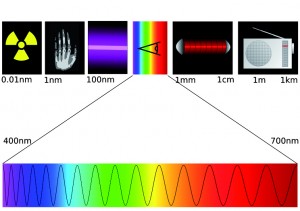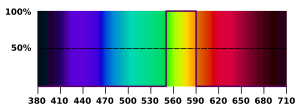Light
Light is the source of life and the foundation of creation. The main source of light on earth is, of course, the sun with its widely varied mixture of rays. The rays, in turn, are based on waves and vibrations in a broad spectrum from .01 nanometers to one kilometer. Only a small fraction of these are visible to the human eye, in the frequency of electromagnetic radiation with wavelengths from 380 to 710 nanometers.
In addition to these wavelengths and the corresponding frequencies, light is also differentiated by the attributes of polarization (the direction of the vibration) and coherence (the dynamic pathway).
In physics, the term “light” is used to refer to the entire electromagnetic spectrum of waves. Light has both wave and particle characteristics, something which was long considered contradictory. This wave-particle duality is now explained by quantum physics, in which wave and particle characteristics are mutually dependent and complementary. Quantum electrodynamics gives us the most exact physical definition of light, for it confirms the particle model and defines the particles as photons that possess no mass when at rest and move at the speed of light independently of any movement by an observer. The speed of light is also the foundation of the theory of relativity, since it is the top speed of all movement. Inside matter, the speed of photons decreases, but they continue to move between particles at the speed of light.
Color
Through a prism (an optical grid), this multicolored light can be filtered into its monochromatic components. Each of these components corresponds to the sensation of a color, together called the spectral colors, for humans. They can be observed in the beautiful rainbow when a prism of water particles breaks up the sunlight. The seven color areas each receive different color tones that are actually electromagnetic rays.
So the spectral colors of violet, indigo, blue, green, yellow, orange and red are in turn based on light and their mixtures produce, with fluid borders, all other shades of color. For example, the transition from green to blue is cyan (turquoise). Other colors visible to the human eye, such as brown, are derived from corresponding light increments through subtractive color mixing of filtered white light, or by overlaying multiple wavelengths (additive color mixing from yellow, red and black). However, it should be noted that black and white do not fall into the category of colors.
Note:
The electromagnetic rays that fall below the wavelengths visible to the human eye, that is, with wavelengths between that of violet, 380 nanometers and a certain lower frequency, are called ultraviolet or UV rays.
The rays with wavelengths between that of red, 710 nanometers and a certain upper wavelength are called infrared rays.
This is just a small excerpt from the book GAIA LEGACY.


